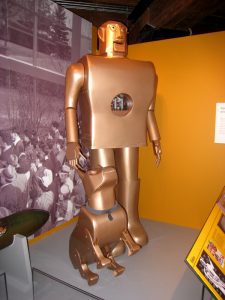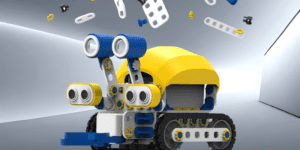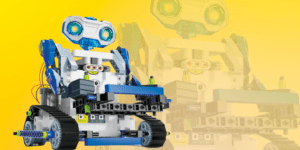Spis treści:
Today we will look at robots in a little more detail, but it will be even simpler. Following in the footsteps of part one, we won’t go into very complex detail, but we will learn a little about what a robot must have in order to work.
In part one we rather quickly flashed through the history of the development of the science that is robotics in general. We already know that it has a rich past. We also recognised what we expect or would like to expect from robotics in the future. We already know what automation means and we know that robots are serving us more and more in many simple tasks. But you can’t see much through the windows of a fast-moving train, so today we are going to try to do it a bit more carefully and put everything in order.
Let’s imagine that we are planning to buy a car or some technical device. It has the functions we are interested in and can do a lot of cool stuff. First we look through the catalogue – a newspaper or a brochure that describes everything in a colourful way. Looks great. Then the instruction manual comes into our hands. It is usually written in such a simple way that we can understand everything needed to set it up.
Interesting on the outside, and even more on the inside
Sometimes we need a knowledge base that the manual does not provide. We can look at technical diagrams – many find them rather boring. Others, however, see something completely different in them. They understand the signs and symbols as well as the house, trees and fence painted in elementary school art class. Reading and decoding- these two words have different meanings. It is like sometimes you can look but not see, or listen but not really hear at all.
A house and a house. Which picture do you like better? Whichever you choose, one cannot exist without the other. A scheme describes the final shape of a house. It is a guideline for the builder, constructor or designer. Finished project realises what the diagram (umm, project…?) shows. It’s like a robot: it won’t be complete without certain elements that must be understood by whoever works with it.
First things first. Fear of the new
The first trains were frightening. Fast walking is 5-6 kilometres per hour. With a load we walk even slower. A horse-drawn carriage moved not much faster. The first railway line, which was built long before cars, in 1825, brought to mind the question: why so fast? The design speed of the first steam locomotive in 1829 was a staggering 48 kilometres per hour (30 mph). It was called the Stephenson’s Rocket, after its designer, Robert Stephenson.
The reputation and general opinion of trains was impaired by the first serious accident involving a man in 1830. But did this stop their development? We have not given up on trains despite the fears of those who used them first. They soon caught on. Today, the Japanese Maglev magnetic train reaches speeds of over 600 kilometres per hour (372 mph).


The first trains were only used in industrial plants and mines. They were powered by the muscles of draught animals or people. The steam engine changed everything. New railway lines were built. Towns and cities sprang up alongside them. In time, there were electric trains and then diesel trains. No one expected them to make such rapid passenger journeys. In time they began to carry animals, milk, mail, grain, goods, timber and paper. We liked them and fell in love with them.
First real robots
It was no different with robots. The first ideas aroused keen interest, but there was also some fear. In the past, we wrote about the first robots, which today can hardly be called real robots. Today we fear that the rapid development of robots will affect our lives in a negative way. However, robots are still developing. We find new tasks and they make our lives easier in unprecedented ways. Even the smart household hoover, which recognises the table and the sofa to avoid colliding with them, is a robot.
And what did the first real robot created for specific tasks look like? It was created in 1947. It had an electric drive. It was called the Mechanical Lobster. “Animal” was to be used to explore the underwater world and wrecks on the seabed. This type of robot was referred to as a teleoperator.

Image source: Cybernetic ZOO
Teleoperation sounds quite complicated, but it simply means the operation of a system or machine at a distance. This term is rather used by scientists, researchers and engineers. Let’s stay with the term remote control. Ten years earlier, in 1937, the world was introduced to Elektro – a human-shaped robot developed in the USA. It weighed 120 kilograms (264 lbs), walked around, smoked cigarettes and inflated balloons, but was more like a toy and simply an interesting presentation. He had photoelectric eyes that recognised red and green light, and in 1940 he was given a robot dog called Sparko to accompany him.
The robots that emerged in the second half of the twentieth century were used in commerce and manufacturing, then they began to support medicine and the military, and finally, at the end of this road, they came into our homes. And it seems that our electronic and robotic colleagues are getting more and more comfortable in them. Elektro and Sparko could not have predicted that the next generation of robots would become so popular. Nor do we know whether their designers actually suspected it, but they certainly dreamed of it.

What did the robot have to have?
Initially, robots were designed to perform simple material handling tasks. Just like our lobster. A robot had a work programme. This is a set of instructions that describes in a language the robot understands what it has to do for us. The program contained a closed list of movements from point A to point B. This included closing and opening the gripper, i.e. gripping and putting down the object to be moved, just as we do when we want to move something from place to place.
The robots were not equipped with any external sensors, which we could call the eyes and ears of the robot. It was not until robots were used for more complex tasks such as welding, blunting edges or assembly that designers developed truly complex devices. Robots thus quickly gained the ability to perform complex movements, and sensors, the robots’ senses, allowed them to interact with their environment.
Before we go any further, it’s worth putting something else in order. The robots we have described would be called manipulators.
A manipulator is a mechanism designed to perform certain functions of the human upper limb. We can distinguish between two types of manipulator function. The manipulator function is performed by a gripper. The extension function is performed by the arm. This is the hand, or more precisely: the robotic arm.

A robot is a technical device designed to perform some of the manipulation and movement functions of a human being. It has a certain level of energy, information and even machine intelligence. Machine intelligence is autonomous action in the environment – without constant control by whoever is controlling the robot.

Robot senses
Let us look at it this way. We have five senses:
- sight,
- hearing,
- smell,
- taste,
- touch.
Robot vision. A robot with a sense of sight can read, for example, colours, gestures, barcodes and information on labels. It can be assisted in this by light sensors or gesture sensors. For some time now, vision functions for robots and similar machines have even been provided by laser scanners that observe and recognise elements of the environment on which the device “looks”.
Robot hearing. Sound sensors, acoustic fall sensors with microphone and vibration sensors are transducers – just like our hearing organs that process sounds. They detect vibrations in the form of waves at different frequencies and convert them into an electrical signal. Again, we see the similarities – our brain also has electrical activity and it can be measured.
Robot smell. Here it is a bit more difficult. Or rather: different. The way we perceive smells is influenced by our memories and associations – just like with images and sounds. We learn about the world through experience and we associate certain things with good, others with bad, and certainly other people may have completely different associations. Thanks to gas sensors and air purity sensors, the robot may not be able to distinguish the smell of raspberry pie from the smell of tulips, but it will detect, for example, chemical compounds in the air that are harmful to humans.
Robot taste. Fortunately, we don’t need to feed our robots! But they need power to function properly just as we need food or plants need sunlight. After all, nothing moves on its own. If we combine nutrition with taste, then in addition to a power source, current sensors come in handy to help control various phenomena such as power or resistance, which we learn about in physics lessons. Sounds complicated? Let’s look at it this way: we too need to measure the calories and nutritional value of our food. We measure blood pressure in the same way that robot enthusiasts measure the current flowing in a circuit under test.
Robot touch. This is where the options are greatest. Touch can take many forms. Why? Because we use it to determine a lot of things. Just like other senses, it provides us with information from the environment. Depending on its role, a robot may understand the distance to an object, orient itself thanks to a device such as a gyroscope, control its movement and acceleration thanks to an accelerometer and have a built-in compass, i.e. a magnetometer. Equally important are magnetic sensors, reflective sensors, pressure sensors or fingerprint readers. Our skin also “feels” temperature and its changes, and so a robot can have a humidity sensor and a temperature sensor.
We can see that performing many tasks combines information from many senses. Robots also learn about the world a little differently than we do, for example they detect even very small changes in magnetic fields that are imperceptible to us. Some sensors don’t even fit the description of our senses at all!
No less important here is the way they move. Mobile robots are devices that can drive, walk (step), fly and swim. Sometimes they can only do one of these activities, sometimes several. They perform different tasks. These are often similar to the tasks of animals with limbs (vertebrates) or legs (insects). They move by means of tracks, wheels or moving limbs.
For the ambitious: robot generations
Generation I robots are robots programmed to do a particular activity over and over again. They can be reprogrammed to do something else. This generation of robots mostly used an open control system. Such a robot is characterised by a complete lack of feedback from the state of the object it is handling – this means that if the cardboard box it is carrying falls over, the robot cannot cope with the task.
Generation II robots are robots equipped with a closed control system and sensors allowing measurements to be made of the state of the robot and the environment. The robot recognises an object even when it is moving with other objects. It can also recognise it regardless of its position and geometric shape. Such robots implement these requirements by means of a set of sensors.
Generation III robots are robots equipped with a closed control system and sensors that allow very complex measurements. They recognise shapes and even understand the situations in which they find themselves. They often have adaptive capabilities, i.e. the ability to adjust to their environment. We can communicate with many using voice recognition.
Expect to see a growing variety of sensors in robotics that will give robots even better orientation in the world. Better orientation also means more safety and the ability to perform more and more tasks in a safe way. Sensors will be combined in modules that will simplify the reception of information, reduce operating costs and meet increasing demands. In the future, devices will certainly be safer, more aware, more agile and more user-friendly. Fourth and fifth generation robots will have adaptive control and full intelligence. But we still have to wait for that.
Remember that today’s description of robots is a major simplification. Nothing can replace real tech knowledge. The most interesting thing, however, is that the way to get to know robots better and to understand them as an architect understands a house plan, is to learn about natural sciences. The march of a column of ants or the flight of a bird in the clouds can tell us more about robots and how they work than we think.



How useful was this post?
Click on a star to rate it!
Average rating 0 / 5. Vote count: 0
No votes so far! Be the first to rate this post.






